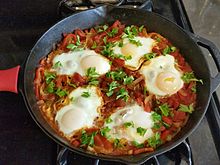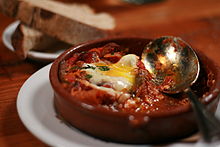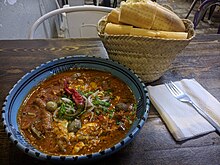This is an old revision of this page, as edited by Duponiuex (talk | contribs) at 21:18, 29 October 2022 (Better before, also using scare quotes for 'Israeli cuisine' is a clear NPOV violation, since it presents the accusation of "appropriation" as a fact, which is disputed to put it mildly). The present address (URL) is a permanent link to this revision, which may differ significantly from the current revision.
Revision as of 21:18, 29 October 2022 by Duponiuex (talk | contribs) (Better before, also using scare quotes for 'Israeli cuisine' is a clear NPOV violation, since it presents the accusation of "appropriation" as a fact, which is disputed to put it mildly)(diff) ← Previous revision | Latest revision (diff) | Newer revision → (diff) Maghrebi dish of eggs poached in a sauce For the shredded flatbread and chickpea dish, see Chakhchoukha. For the Turkish eggplant dish, see Şakşuka. For the documentary film, see The Shakshuka System. Shakshouka in a cast iron pan Shakshouka in a cast iron pan | |
| Alternative names | Shakshuka, chakchouka |
|---|---|
| Type | Main dish |
| Region or state | Maghreb |
| Main ingredients | Tomatoes, harissa, eggs, olive oil |

Shakshouka (Template:Lang-ar : šakšūkah, also spelled shakshuka or chakchouka) is a Maghrebi dish of eggs poached in a sauce of tomatoes, olive oil, peppers, onion and garlic, commonly spiced with cumin, paprika and cayenne pepper. According to Joan Nathan, shakshouka originated in Ottoman North Africa in the mid-16th century after tomatoes were introduced to the region by Hernan Cortés as part of the Columbian exchange.
Etymology
The word shakshouka (Template:Lang-ar) is a Maghrebi Arabic term for "a mixture". The exact provenance of the word is often contested, but, like the names of many Maghrebi dishes and terms, is believed to come from the language of the Amazigh (or Berber) people indigenous to the region. In the western Maghreb, it is referred to as bīd wu matiša (بيض ومطيشة "egg and tomato").
History
The origin of the dish remains a matter of some controversy with competing claims of Libyan, Moroccan, Tunisian, Turkish, Algerian and Yemeni origins. Tomatoes and peppers are notably New World ingredients that only became common ingredients in later centuries after the Columbian exchange.
The dish has also been part of Sephardic cuisine for centuries, and was brought to Israel by Jewish immigrants from Libya and Tunisia in the 1950s and 1960s, though it only became popularised on menus in the 1990s. Much of its current popularity in Israel is due to Bino Gabso [he], the son of Jewish emigrants from Tripoli, who in 1991 took over his father's restaurant in Jaffa and changed its name to Dr Shakshuka.
The dish has since been globally popularised, a trend that may in part have been helped by the 2012 cookbook on Jerusalem cuisine by Jewish Israeli chef Yotam Ottolenghi and his Palestinian business partner Sami Tamimi. Israeli food writer Gil Hovav [he], has credited the international popularity of dishes like shakshouka to Ottolenghi and Tamimi's book. Some have accused Israel of cultural appropriation which chef Michael Solomonov dismissed: "To say that this is stolen food – not only is it inaccurate, it’s just lazy. The real reason that everybody in that region cooks the way they do is because of the Ottomans."
Variations

Many variations of the basic sauce are possible, varying in spice and sweetness. Some cooks add preserved lemon, salty sheep milk cheeses, olives, harissa or a spicy sausage such as chorizo or merguez. Shakshouka is made with eggs which are commonly poached but can also be scrambled like the Turkish menemen.
Some variations of shakshouka can be made with lamb mince, toasted whole spices, yogurt and fresh herbs. Spices can include ground coriander, caraway, paprika, cumin and cayenne pepper. Tunisian cooks may add potatoes, broad beans, artichoke hearts or courgettes to the dish. The North African dish matbukha can be used as a base for shakshouka.
A shakhsouka made with a kosher version of Spam (called loof) was added to IDF army rations in the 1950s. Because eggs are the main ingredient, it is often on breakfast menus in English-speaking countries, but in the Arab world as well as Israel, it is also a popular evening meal, and like hummus and falafel, is a Levantine regional favorite. On the side, pickled vegetables and North African sausage called merguez might be served, or simply bread, with mint tea.
In Jewish culture, a large batch of tomato stew is made for the Sabbath dinner and the leftovers used the following morning to make a breakfast shakshouka with eggs. In Andalusian cuisine, the dish is known as huevos a la flamenca; this version includes chorizo and serrano ham. in Italian cuisine, there is a version of this dish called uova in purgatorio (eggs in purgatory) with tomato paste, anchovy, garlic and parsley and sometimes parmesan cheese.
See also
References
- Nathan, Joan (2017). A Culinary Exploration of Jewish Cooking from Around the World: A Cookbook. Knopf Doubleday Publishing. p. 16. ISBN 9780385351157.
Shakshuka was born in Ottoman North Africa in the mid-sixteenth century
- Ellis, Robin (2016-03-03). Mediterranean Cooking for Diabetics: Delicious Dishes to Control or Avoid Diabetes. Little, Brown Book Group. ISBN 9781472136381. Archived from the original on 2017-11-16. Retrieved 2017-11-15.
- Ly, Linda (2015-03-20). The CSA Cookbook: No-Waste Recipes for Cooking Your Way Through a Community Supported Agriculture Box, Farmers' Market, Or Backyard Bounty. Voyageur Press. ISBN 9780760347294. Archived from the original on 2017-11-16. Retrieved 2017-11-15.
- Planet, Lonely (2017-03-01). The World's Best Superfoods. Lonely Planet. ISBN 9781787010369. Archived from the original on 2017-11-16. Retrieved 2017-11-15.
- Bilderback, Leslie (2015-09-01). Mug Meals: More Than 100 No-Fuss Ways to Make a Delicious Microwave Meal in Minutes. St. Martin's Press. ISBN 9781466875210. Archived from the original on 2017-11-16. Retrieved 2017-11-15.
- Jakob, Ben. "How Shakshuka,, Took the World By Storm". Culture Trip. Archived from the original on 2017-11-16. Retrieved 2017-11-15.
- ^ Fitzgerald, Mary (Apr 24, 2021). "Shakshuka: All mixed up over a brilliant breakfast". The Irish Times. Retrieved 2021-09-09.
- "وداعا "البيض ومطيشة"". Hespress - هسبريس جريدة إلكترونية مغربية (in Arabic). 2012-10-16. Retrieved 2022-01-26.
- ^ Josephs, Bernard (2009-10-08). "Shakshuka: Israel's hottest breakfast dish". The Jewish Chronicle. Archived from the original on 2017-08-08. Retrieved 2017-08-07.
- Global Jewish Foodways: A History. University of Nebraska Press. 2018. p. 104. ISBN 9781496202284.
- ^ Artzeinu: An Israel Encounter, By Joel Lurie Grishaver, 2008
- ^ Gil Marks, Encyclopedia of Jewish Food, Houghton Mifflin Harcourt, 2010, ISBN 9780470391303, s.v., p. 547
- "'At 70'- From Jaffa oranges to gourmet shakshuka". Jerusalem Post.
- "Shakshuka recipe". The Guardian. February 18, 2012.
- Gordon, Peter (2018-06-03). "Peter Gordon's lamb shakshouka recipe". The Guardian. ISSN 0261-3077. Retrieved 2018-07-21.
- "Shakshouka Recipe - Tunisian Recipes". PBS Food. 2015-03-12. Retrieved 2018-07-21.
- Clark, Melissa. "Shakshuka With Feta Recipe". NYT Cooking. Retrieved 2018-07-21.
- Claudia Roden (1996). The Book of Jewish Food: An Odyssey from Samarkand to New York. Knopf. p. 512. ISBN 9780394532585.
- Gur, Janna (2014). Jewish Soul Food: From Minsk to Marrakesh.
- Steinberg, Jessica (20 November 2012). "The rationale behind the rations". The Times of Israel.
- Raviv, Yael (November 2015). Falafel Nation: Cuisine and the Making of National Identity in Israel. University of Nebraska Press. p. 171. ISBN 978-0-8032-9023-5.
- Clifford-smith, Stephanie (2011-06-07). "Three of a kind ... shakshouka". Sydney Morning Herald. Archived from the original on 2017-08-08. Retrieved 2017-08-07.
- Ashkenazi, Michael (2020). Food Cultures of Israel: Recipes, Customs, and Issues. p. 89.
- Tish, Ben (2019). Moorish: Vibrant Recipes from the Mediterranean. Bloomsbury. p. 46. ISBN 9781472958082.
- "Eggs in Purgatory Recipe". NYT Cooking. Retrieved 2021-04-14.
External links
 Quotations related to Shakshouka at Wikiquote
Quotations related to Shakshouka at Wikiquote
| Cuisine of Tunisia | |
|---|---|
| Breads, dishes, and soups | |
| Ingredients | |
| Beverages | |
| Desserts and pastries | |
| Related | |
| Algerian cuisine | |
|---|---|
| Dishes | |
| Soups | |
| Brochettes | |
| Ingredients | |
| Beverages | |
| Desserts and pastries | |
| Related | |
| Moroccan cuisine | |
|---|---|
| Dishes (list) | |
| Brochettes | |
| Ingredients | |
| Soups | |
| Breads | |
| Desserts & pastries | |
| Beverages | |
| Related cuisines | |
- Arab cuisine
- Libyan cuisine
- Tunisian cuisine
- Algerian cuisine
- Moroccan cuisine
- Israeli cuisine
- Egg dishes
- National dishes
- Mizrahi Jewish cuisine
- Sephardi Jewish cuisine
- Maghrebi cuisine
- Ottoman cuisine
- Spanish cuisine
- Italian cuisine
- Meze
- Tomato dishes
- Breakfast
- Transatlantic cultural exchange
- Shabbat food
- Middle Eastern cuisine
- Berber cuisine